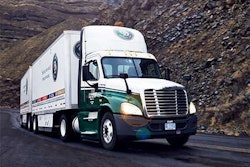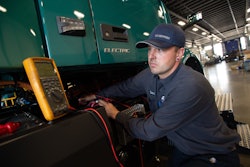
Red herring for lunch anyone?
• “95% of accidents are caused by people.”
• “Electric vehicles burn.”
• “Big trucks cause accidents.”
• “EV fill times are excessive.”
Wikipedia summarizes the phrase “red herring” as “something that misleads or distracts from a relevant or important question. It may be either a logical fallacy or a literary device that leads readers or audiences toward a false conclusion.” If you prefer, insert terms like bias, propaganda, hype, misdirection, con, obfuscation, innuendo, sleight of hand, marketing-speak, what-abouts, etc.
We are continually assaulted by opinions. Separating fact from fiction is challenging. Even more so when parties are purposely misdirecting. Misdirection is an art form perfected by magicians and pickpockets. “Watch this hand” while the other lifts your wallet.
We kick ourselves when we finally realize we've been conned. Sometimes we even admit it to others. Sometimes.
Red herring is a frequent meal in technology businesses. Competition for business is fierce. Freight represents billions of dollars in business. I don’t fault a salesperson for overemphasizing the positive aspects of their product. I expect it. And shame on me if I don’t do the homework to get a more balanced objective view. But I do take exception to red herrings — when one technology advocate claims something about a competing technology that is just not real.
Let’s talk through my top four red herring dishes.
95% of accidents are caused by people.
Okay. I’ll give you that, but how many non-human drivers are out there today? And just who do you think designs the software for autonomous vehicles? And how many non-accidents are due to humans? Avoided accidents is not a metric that is tracked. Collectively we drive some 3.2 trillion miles a year in the U.S. The Mark One human driver, in spite of our human imperfections, has a fairly decent traffic safety track record. We always can do better, like leaving the smart phone off when driving. And ADAS technology like lane keeping assist, collision avoidance and automatic braking, also can help us be better. Software engineering is also not perfect, just look at some recent airplane automation examples. Humans make the major decisions on software.
Electric vehicles burn.
Okay. I’ll give you that, too. But so do gas, diesel and every other powertrain. NACFE wrote about this in detail in Medium Duty Battery Electric Truck Cost of Ownership. Statistically, according to a NHTSA/Battelle 2017 study, electric vehicles are no worse than other powertrain types at catching fire and actually may be less likely to do so. The populations of vehicle types are not yet the same but are sufficient for real-world data to support this premise. A Tesla or Chevy Bolt fire may get international media attention where the daily gasoline car fires we see on the road do not. See for yourself. According to a Federal Emergency Management Agency U.S. Fire Administration report covering 2014-2016 — when EV populations were small — “Approximately one in eight fires responded to by fire departments across the nation is a highway vehicle fire. This does not include the tens of thousands of fire department responses to highway vehicle accident sites.” So yeah, many vehicles can and do burn.
Big trucks cause accidents.
Okay. Sometimes. This topic is an emotional one, and liability for accidents is complicated. But, according to Department of Transportation data for 2017 the total number of accidents with fatalities each year in the U.S. is about 37,000. Of these, about 5,000 involve commercial vehicles. Of these truck accidents, a 2006 Federal Motor Carrier Safety Administration study estimated 44% are the fault of the commercial vehicle and 56% are attributed to the other vehicles. So, cars cause truck accidents, too. In context of the miles driven per vehicle per year, heavy-duty freight trucks can average, depending on the study group, anywhere from 80,000 to 120,000 miles per year, while cars average about 13,000 miles per year. Safety is a major goal of everyone, and everything can be improved. I’ve stated many times that ADAS systems for cars will inherently reduce truck accident rates. Traffic safety is a crowd-sourced effort involving all the participants.
EV fill times are excessive compared to diesel…or hydrogen.
Okay. Yes, refilling energy takes more time for a battery versus a fuel tank. But the driver’s time is actually often much less. NACFE has been out interviewing early commercial EV users as part of Run on Less - Electric and is finding that drivers in fact spend less time “fueling” EVs. In a New York city example, the driver can be tied up for more than an hour getting to and from a diesel fueling station. In the case of a Modesto, California, facility with an on-site diesel fueling station, the driver can take up to 30 minutes waiting in line, then fueling and returning. NACFE has cited several studies on fill times in our reports, for example in Making Sense of Heavy-Duty Hydrogen Fuel Cell Tractors. The Department of Energy estimates a diesel Class 8 truck typically takes five minutes to fill at 30 gallons per minute per hose. NACFE confirmed from an actual driver that just the fill time excluding the queue time is five to six minutes. Contrast that with an EV driver plugging the truck in and leaving for home. We timed it, filmed it, and interviewed the drivers: 30 seconds max. Really. Sure, fill times depend on duty cycles. But it is not true that EVs are inherently worse than their diesel-powered counterparts.
Recognizing red herring should be easy, right? Unfortunately, they are not clearly red.
When you read anything, take a moment to think about it. Ask questions. Do some research. Try to avoid ordering the red herring on the menu.













